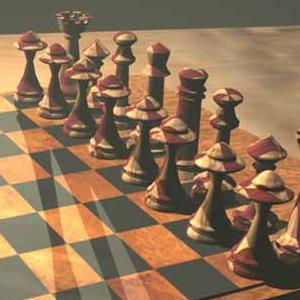TD Exercice 1

Placer
sur un échiquier de taille n, n reines telles qu’aucune
d’entre elles ne soit en prise.
Modéliser
le problème et trouver la solution au problème
en utilisant le solveur Choco 2.0.
Solution
Modèle 1
Comment
modéliser le problème avec les contraintes
déjà évoquées ?
On
associe à chaque ligne une variable précisant
la position de la reine dans le ligne
- Une
variable énumérée par ligne : X1=[[1,n]]
…
- Une
reine par ligne (c’est évident)
- Une
reine par colonne :
- allDifferent(X1,
X2, … Xn)
- Une
reine par diagonale :
- allDifferent(X1+1,
X2+2, … Xn+n)
- allDifferent(X1-1,
X2-2, … Xn-n)
Modèle
plus classique en PPC : moins de variables et moins
de contraintes
Voici
le code java en Choco
2.0 de ce premier modèle :
import
choco.kernel.model.Model;
import choco.kernel.model.variables.integer.IntegerVariable;
import choco.kernel.solver.Solver;
import choco.cp.model.CPModel;
import choco.cp.solver.CPSolver;
import choco.Choco;
public
class NReinesModel1 {
 public
static final int NB_REINES = 10;
public
static final int NB_REINES = 10;
 public
static void main(String[] args) {
public
static void main(String[] args) {

 //
0. Création du problème
//
0. Création du problème

 Model
m = new CPModel();
Model
m = new CPModel();

 //
1. Création des variables
//
1. Création des variables

 IntegerVariable[]
vars = createVariables(m);
IntegerVariable[]
vars = createVariables(m);

 //
2. Création des contraintes
//
2. Création des contraintes

 postConstraints
( m, vars );
postConstraints
( m, vars );

 //
3. Choix solver et heuristique
//
3. Choix solver et heuristique

 Solver
s = new CPSolver ();
Solver
s = new CPSolver ();

 s.read(m);
s.read(m);

 setHeuristic(s);
setHeuristic(s);

 //
4. Résolution du problème
//
4. Résolution du problème

 s.solve();
s.solve();

 //
5. Récupérer la solution
//
5. Récupérer la solution

 displayResult(s,
vars);
displayResult(s,
vars);
 }
}
 //
1. Création des variables
//
1. Création des variables
 private
static IntegerVariable[] createVariables(Model m) {
private
static IntegerVariable[] createVariables(Model m) {

 IntegerVariable[]
vars = new IntegerVariable[NB_REINES];
IntegerVariable[]
vars = new IntegerVariable[NB_REINES];

 for
(int i = 0; i < NB_REINES; i++) {
for
(int i = 0; i < NB_REINES; i++) {


 vars[i]
= Choco.makeIntVar("x" + i, 0, NB_REINES - 1);
vars[i]
= Choco.makeIntVar("x" + i, 0, NB_REINES - 1);

 }
}

 return
vars;
return
vars;
 }
}
 //
2. Création des contraintes
//
2. Création des contraintes
 private
static void postConstraints(Model m, IntegerVariable[] vars)
{
private
static void postConstraints(Model m, IntegerVariable[] vars)
{

 postConstraints1(m,
vars);
postConstraints1(m,
vars);

 postConstraints2(m,
vars);
postConstraints2(m,
vars);
 }
}
 //
2.1. Une reine par colonne
//
2.1. Une reine par colonne
 private
static void postConstraints1(Model m, IntegerVariable[]
vars) {
private
static void postConstraints1(Model m, IntegerVariable[]
vars) {

 for(int
i = 0; i < NB_REINES; i++) {
for(int
i = 0; i < NB_REINES; i++) {


 for(int
j = i+1; j < NB_REINES; j++) {
for(int
j = i+1; j < NB_REINES; j++) {



 m.addConstraint(
Choco.neq(vars[i], vars[j]) );
m.addConstraint(
Choco.neq(vars[i], vars[j]) );


 }
}

 }
}
 }
}
 //
2.2. Une reine par diagonale
//
2.2. Une reine par diagonale
 private
static void postConstraints2(Model m, IntegerVariable[]
vars) {
private
static void postConstraints2(Model m, IntegerVariable[]
vars) {

 for
(int i = 0; i < NB_REINES; i++) {
for
(int i = 0; i < NB_REINES; i++) {


 for
(int j = i + 1; j < NB_REINES; j++) {
for
(int j = i + 1; j < NB_REINES; j++) {



 int
k = j - i;
int
k = j - i;



 m.addConstraint(Choco.neq(vars[i],
Choco.plus(vars[j], k)));
m.addConstraint(Choco.neq(vars[i],
Choco.plus(vars[j], k)));



 m.addConstraint(Choco.neq(vars[i],
Choco.minus(vars[j], k)));
m.addConstraint(Choco.neq(vars[i],
Choco.minus(vars[j], k)));


 }
}

 }
}
 }
}
 //
3. Réglage de l'heuristique de choix de valeurs
//
3. Réglage de l'heuristique de choix de valeurs
 private
static void setHeuristic(Solver s) {
private
static void setHeuristic(Solver s) {

 s.setValIntIterator(new
DecreasingDomain());
s.setValIntIterator(new
DecreasingDomain());
 }
}
 //
5. Affichage des résultats
//
5. Affichage des résultats
 private
static void displayResult(Solver s, IntegerVariable[] vars)
{
private
static void displayResult(Solver s, IntegerVariable[] vars)
{

 if
(s.getNbSolutions() > 0) {
if
(s.getNbSolutions() > 0) {


 System.out.println("Solution
trouvŽe : ");
System.out.println("Solution
trouvŽe : ");


 for
(int i = 0; i < NB_REINES; i++) {
for
(int i = 0; i < NB_REINES; i++) {



 int
val = s.getVar(vars[i]).getVal();
int
val = s.getVar(vars[i]).getVal();



 for
(int j = 0; j < NB_REINES; j++) {
for
(int j = 0; j < NB_REINES; j++) {




 System.out.print(val
== j ? "R " : ". ");
System.out.print(val
== j ? "R " : ". ");



 }
}



 System.out.println("");
System.out.println("");


 }
}

 }
else {
}
else {


 System.out.println("Pas
de solution trouvŽe !!");
System.out.println("Pas
de solution trouvŽe !!");

 }
}
 }
}
Solution
Modèle 2
On
associe à chaque case un booléen (reine présente
ou non)
Xij
= { 0,1 } avec 0 pas reine, 1 une reine
Une
reine par ligne :

De
même pour les colonnes et les diagonales (partielles
ou non).
Modèle
classique à la Programmation Linéaire.
Voici
le code java en Choco
2.0 de ce second modèle :
import
choco.kernel.model.Model;
import choco.kernel.model.variables.integer.IntegerVariable;
import choco.kernel.solver.Solver;
import choco.cp.model.CPModel;
import choco.cp.solver.CPSolver;
import choco.cp.solver.search.integer.valiterator.DecreasingDomain;
import choco.Choco;
import
java.util.List;
import java.util.ArrayList;
public
class NReineModele2 {
 public
static final int NB_REINES = 10;
public
static final int NB_REINES = 10;
 public
static void main(String[] args) {
public
static void main(String[] args) {

 long
time = System.currentTimeMillis();
long
time = System.currentTimeMillis();

 System.out.println("NReine
mod?le 1");
System.out.println("NReine
mod?le 1");

 //
0. Création du problème
//
0. Création du problème

 Model
m = new CPModel();
Model
m = new CPModel();

 //
1. Création des variables
//
1. Création des variables

 IntegerVariable[]
vars =
IntegerVariable[]
vars =

 createVariables(m);
createVariables(m);

 //
2. Création des contraintes
//
2. Création des contraintes

 postConstraints(m,
vars);
postConstraints(m,
vars);

 //
3. Choix solver et heuristique
//
3. Choix solver et heuristique

 Solver
s = new CPSolver();
Solver
s = new CPSolver();

 s.read(m);
s.read(m);

 setHeuristic(s);
setHeuristic(s);

 //
4. Résolution du problème
//
4. Résolution du problème

 s.solve();
s.solve();

 //
5. Récupération de la solution
//
5. Récupération de la solution

 displayResult(s,
vars);
displayResult(s,
vars);

 System.out.println("Time
ellapsed: " + (System.currentTimeMillis() - time) +
"ms.");
System.out.println("Time
ellapsed: " + (System.currentTimeMillis() - time) +
"ms.");
 }
}
 //
1. Création des
variables
//
1. Création des
variables
 private
static IntegerVariable[] createVariables(Model m) {
private
static IntegerVariable[] createVariables(Model m) {

 IntegerVariable[]
vars = new IntegerVariable[NB_REINES * NB_REINES];
IntegerVariable[]
vars = new IntegerVariable[NB_REINES * NB_REINES];

 for
(int i = 0; i < NB_REINES; i++) {
for
(int i = 0; i < NB_REINES; i++) {


 for
(int j = 0; j < NB_REINES; j++) {
for
(int j = 0; j < NB_REINES; j++) {



 vars[index(i,
j)] = Choco.makeIntVar("x" + i + "_"
+ j, 0, 1);
vars[index(i,
j)] = Choco.makeIntVar("x" + i + "_"
+ j, 0, 1);


 }
}

 }
}

 return
vars;
return
vars;
 }
}
 //
2. Création des
contraintes
//
2. Création des
contraintes
 private
static void postConstraints(Model m, IntegerVariable[] vars)
{
private
static void postConstraints(Model m, IntegerVariable[] vars)
{

 postConstraints1(m,
vars);
postConstraints1(m,
vars);

 postConstraints2(m,
vars);
postConstraints2(m,
vars);
 }
}
 //
2.1. Une occurence par ligne et par colonne
//
2.1. Une occurence par ligne et par colonne
 private
static void postConstraints1(Model m, IntegerVariable[]
vars) {
private
static void postConstraints1(Model m, IntegerVariable[]
vars) {

 IntegerVariable
one = Choco.makeConstantVar("one", 1);
IntegerVariable
one = Choco.makeConstantVar("one", 1);

 for
(int i = 0; i < NB_REINES; i++) {
for
(int i = 0; i < NB_REINES; i++) {


 IntegerVariable[]
col = new IntegerVariable[NB_REINES];
IntegerVariable[]
col = new IntegerVariable[NB_REINES];


 IntegerVariable[]
line = new IntegerVariable[NB_REINES];
IntegerVariable[]
line = new IntegerVariable[NB_REINES];


 for
(int j = 0; j < NB_REINES; j++) {
for
(int j = 0; j < NB_REINES; j++) {



 col[j]
= vars[index(i, j)];
col[j]
= vars[index(i, j)];



 line[j]
= vars[index(j, i)];
line[j]
= vars[index(j, i)];


 }
}


 m.addConstraint(Choco.occurrence(1,
one, col));
m.addConstraint(Choco.occurrence(1,
one, col));


 m.addConstraint(Choco.occurrence(1,
one, line));
m.addConstraint(Choco.occurrence(1,
one, line));

 }
}
 }
}
 //
2.2 Une
occurence par diagonale
//
2.2 Une
occurence par diagonale
 private
static void postConstraints2(Model m, IntegerVariable[]
vars) {
private
static void postConstraints2(Model m, IntegerVariable[]
vars) {

 IntegerVariable
one = Choco.makeConstantVar("one", 1);
IntegerVariable
one = Choco.makeConstantVar("one", 1);

 for
(int diag = 0; diag < 2 * NB_REINES - 1; diag++) {
for
(int diag = 0; diag < 2 * NB_REINES - 1; diag++) {


 List<IntegerVariable>
diag1 = new ArrayList<IntegerVariable>();
List<IntegerVariable>
diag1 = new ArrayList<IntegerVariable>();


 List<IntegerVariable>
diag2 = new ArrayList<IntegerVariable>();
List<IntegerVariable>
diag2 = new ArrayList<IntegerVariable>();


 for
(int i = 0; i < NB_REINES; i++) {
for
(int i = 0; i < NB_REINES; i++) {



 int
index1 = index(i, i + diag - NB_REINES + 1);
int
index1 = index(i, i + diag - NB_REINES + 1);



 int
index2 = index(NB_REINES - i - 1, i + diag - NB_REINES +
1);
int
index2 = index(NB_REINES - i - 1, i + diag - NB_REINES +
1);



 if
(index1 >= 0 && index1 < NB_REINES * NB_REINES)
{
if
(index1 >= 0 && index1 < NB_REINES * NB_REINES)
{




 diag1.add(vars[index1]);
diag1.add(vars[index1]);



 }
}



 if
(index2 >= 0 && index2 < NB_REINES * NB_REINES)
{
if
(index2 >= 0 && index2 < NB_REINES * NB_REINES)
{




 diag2.add(vars[index2]);
diag2.add(vars[index2]);


 }
}

 }
}

 m.addConstraint(Choco.occurrenceMax(1,
one, diag1.toArray(new IntegerVariable[]{})));
m.addConstraint(Choco.occurrenceMax(1,
one, diag1.toArray(new IntegerVariable[]{})));

 m.addConstraint(Choco.occurrenceMax(1,
one, diag2.toArray(new IntegerVariable[]{})));
m.addConstraint(Choco.occurrenceMax(1,
one, diag2.toArray(new IntegerVariable[]{})));

 }
}
 }
}
 //
3. Réglage de l'heuristique
//
3. Réglage de l'heuristique
 private
static void setHeuristic(Solver s) {
private
static void setHeuristic(Solver s) {

 s.setValIntIterator(new
DecreasingDomain());
s.setValIntIterator(new
DecreasingDomain());
 }
}
 //
5. Affichage des résultats
//
5. Affichage des résultats
 private
static int index(int i, int j) {
private
static int index(int i, int j) {

 if
(i < 0 || i >= NB_REINES) return -1;
if
(i < 0 || i >= NB_REINES) return -1;

 if
(j < 0 || j >= NB_REINES) return -1;
if
(j < 0 || j >= NB_REINES) return -1;

 return
i * NB_REINES + j;
return
i * NB_REINES + j;
 }
}
 //
5. Affichage des résultats
//
5. Affichage des résultats
 private
static void displayResult(Solver s, IntegerVariable[] vars)
{
private
static void displayResult(Solver s, IntegerVariable[] vars)
{

 if
(s.getNbSolutions() > 0) {
if
(s.getNbSolutions() > 0) {


 System.out.println("Solution
trouvée : ");
System.out.println("Solution
trouvée : ");


 for
(int i = 0; i < NB_REINES; i++) {
for
(int i = 0; i < NB_REINES; i++) {



 for
(int j = 0; j < NB_REINES; j++) {
for
(int j = 0; j < NB_REINES; j++) {




 System.out.print(s.getVar(vars[index(i,
j)]).getVal() == 1 ? "R " : ". ");
System.out.print(s.getVar(vars[index(i,
j)]).getVal() == 1 ? "R " : ". ");



 }
}



 System.out.println("");
System.out.println("");


 }
}

 }
}

 else
{
else
{


 System.out.println("Pas
de solution trouvée !!");
System.out.println("Pas
de solution trouvée !!");

 }
}
 }
}
}
Voici
le plan de cette présentation sur la programmation par contraintes
- Les
notions de base
:
- Quelques
notions avancées :
- Quelques
exemples pour utiliser la P.P.C. :
Cette page
a été co-réalisée avec Guillaume
Rochart, docteur en mathématiques dans mon équipe de
recherche au Bouygues
e-lab.10/03/2009.
